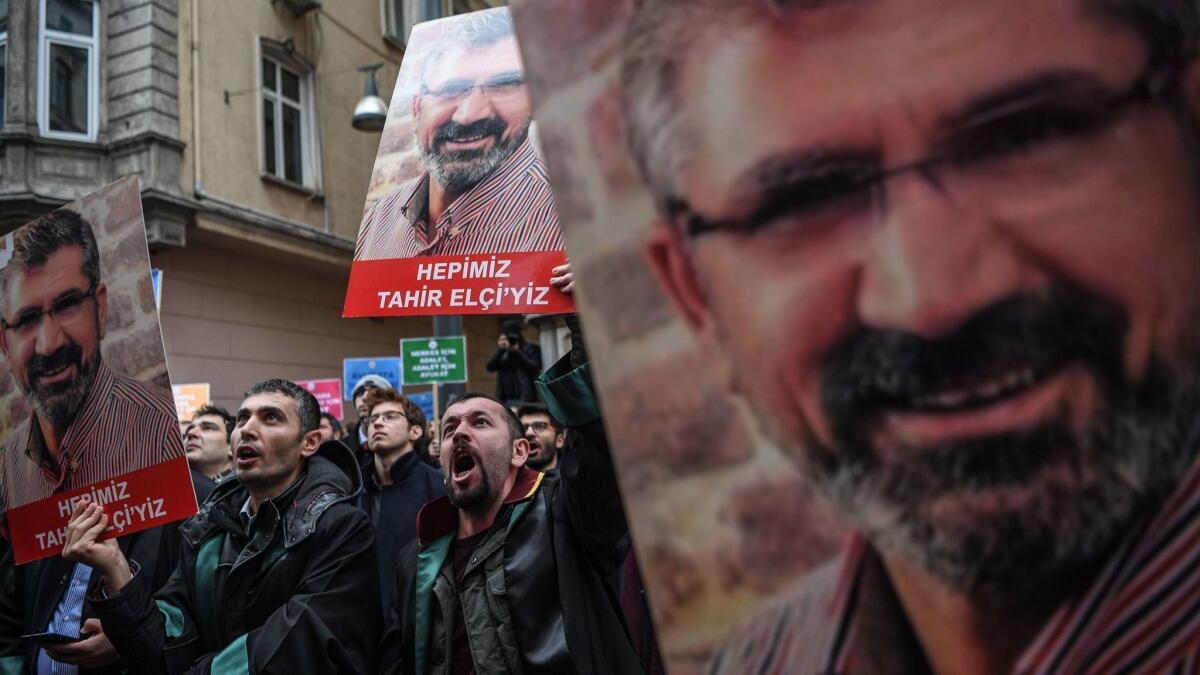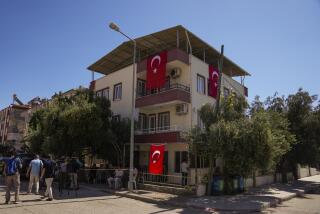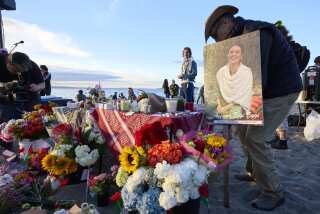Turkish human rights lawyer may have been killed by a cop, high-tech independent investigation shows

- Share via
Reporting from DIYARBAKIR, Turkey — When Turkish human rights lawyer Tahir Elci was gunned down during a news conference in the embattled Kurdish-majority city of Diyarbakir, at least four cameras were rolling and dozens of witnesses were looking on in horror.
But more than three years later, nobody has been arrested. Police officers, chasing two men who had just killed a pair of cops around the corner, were seen firing in Elci’s direction. But authorities have apparently never investigated whether one of them may have, on purpose or by mistake, killed Elci, who was struck by a bullet to the head.
The tragedy accelerated a breakdown in a two-year cease-fire between Turkey and the Kurdistan Workers Party, or PKK, a separatist group that has waged an insurgency since the 1980s. At least 4,258 people have been killed in the conflict since July 2015, including 464 civilians and 1,140 security personnel, according to the International Crisis Group.
With the stall in efforts to determine who killed the prominent attorney, a high-tech independent investigation was launched by the Diyarbakir Bar Assn., which Elci used to head — and it has identified three police officers who could have fired the lethal round.
“After this study, which is entirely based on scientific evidence, three police officers are strong suspects,” says Cemal Aydin, who now serves as chair of the bar association.
Prosecutors had been given a copy of the study released this month, Aydin said, and “we expect statements to be taken from these police officers as soon as possible, and arrest warrants to be issued for them…. We will not wait forever. We will watch what investigators will do, whether they do not take the report seriously, or they send it to experts” to be studied.
The study, commissioned by the bar association in 2016, was undertaken by Forensic Architecture, a London-based research agency that investigates crimes with global relevance.
“We have spent years looking at every frame captured by every camera,” said Eyal Weizman, director of Forensic Architecture.
“We almost know by heart the 40-odd shots fired on Yenikapi Street that morning, who fired them and in which direction,” he added, referring to the street where Elci was killed.
In the months leading up to Nov. 28, 2015, Elci had joined other human rights activists in Turkey in documenting the human toll of the conflict between Ankara and the PKK. Elci appeared on a Turkish news channel and said the PKK should not be called a terrorist group, because it enjoyed significant public support.The remark sparked an official investigation, and colleagues say he began receiving death threats.
The morning he was killed, Elci, 49, had called a news conference in Diyarbakir’s historic Sur district to highlight damage to historic buildings. PKK-affiliated fighters had set up checkpoints, dug trenches and declared autonomy in Sur, a UNESCO World Heritage site known for winding cobblestone alleys, traditional Kurdish homes, and churches, mosques and fortifications dating back thousands of years.
Elci stood before a five-century-old minaret, famed for the four columns it is perched atop, referred to as “feet” by locals, to highlight the damage the fighting was causing. “They shot me in the foot,” read a placard attached to the columns for the occasion.
Around the corner, police stopped a taxi on Gazi Boulevard, a main thoroughfare in Central Sur. Two passengers emerged and opened fire, killing two police officers, and then ran in the direction of Elci’s news conference.
“What’s that?” Elci is seen saying in one video, as the sound of gunfire approaches. By then, dozens of police were chasing the two suspects. As they ran past Elci and the historic minaret, a hail of gunfire followed. The camera pans back toward the minaret, and Elci is seen lying face down nearby, blood streaming from his head, a handgun next to his body.
Speaking to reporters that day, Prime Minister Ahmet Davutoglu praised Elci’s work, and vowed the state would investigate. “We will not allow murders to go unsolved in our era,” he said. “Whoever did this, the target was not only Mr. Tahir Elci, the target was Turkey.”
Davutoglu’s ruling Justice and Development Party was credited for largely ending widespread human rights abuses by security forces in Turkey’s southeast after it came to power in 2002. According to Human Rights Watch, government forces had carried out thousands of enforced disappearances and extrajudicial killings in the 1990s.
Elci fought courtroom battles for victims of such cases, including the killing of 38 Kurdish villagers by Turkish airstrikes in 1994. In 2013, the European Court of Human Rights ordered Turkey to pay $2.6 million in compensation to the victims’ families.
To many in Diyarbakir today, there is no indication Turkish authorities are serious about finding out who shot him — or why.
“I was not hopeful then, and I am not hopeful now,” said Baris Yavuz, a fellow lawyer. “To solve a case, you need political will behind it. But this political will is not behind Tahir Elci’s case.”
Turkish officials say investigators attempted to visit the scene of the crime twice but were forced to leave because of clashes between PKK fighters and security forces.
Hundreds of Turkish soldiers, backed by tanks and armored cars, fought a months-long battle in Sur that displaced tens of thousands of residents. When it ended in March 2016, much of the ancient district lay in ruins. At least 339 people were killed, among them a 13-year-old girl and 60 security personnel, according to government statistics.
Most of Sur’s residents have not been allowed back since, and many streets leading into the district are blocked by concrete barriers. Giant blue tarps have been hung up to block views in, and along the once-bustling Gazi Boulevard, authorities have evacuated residents and businesses higher than the ground floor.
It wasn’t until the fighting concluded that prosecutors conducted a forensics sweep of the shooting scene. Four months after the slaying, they announced they had found the cartridge from the bullet that killed Elci.
Since then, officials have repeatedly floated the idea that the two PKK suspects fleeing police killed Elci in an effort to instigate further violence. One of the men, named as Mahsun Gurkan by prosecutors, was killed in clashes in the city in March 2016. Another claim from officials has it that an unidentified and unseen PKK sniper shot Elci.
Opposition leaders and others have claimed Turkish authorities carried out a targeted killing of Elci, obscuring their responsibility by staging what appeared to be a routine clash between police and PKK members.
One reason for carrying out the investigation, said Weizman of Forensic Architecture, was to help dispel unfounded rumors, especially for a killing that resulted in the escalation of the conflict in southeastern Turkey.
“There was huge confusion around this incident, who did it and out of whose gun the bullet that entered Tahir’s skull was fired,” Weizman said.
None of the footage available to the public captured Elci as he was shot. “If the moment he was hit was captured on camera, it would have been a much simpler investigation. But in this case, you needed to reconstruct what is happening off screen, and this is where you need 3-D modeling,” Weizman said.
Investigators at Forensic Architecture took the videos provided to them by lawyers in Diyarbakir, along with testimony from witnesses, satellite imaging and other evidence to re-create the scene. Distinct sounds in the four videos, witness accounts — even a stray cat dashing across the street — were used to synchronize the evidence.
As the two suspected PKK members enter Yenikapi Street, police — some in pursuit, others in plainclothes for Elci’s news conference — open fire. One of the suspects throws a handgun in Elci’s direction — which explains the gun found next to his body — then runs farther into the street as police continue firing after him.
Of a total of 40 gunshots recorded in the videos, investigators were able to confirm police fired 26. Accounting for witness testimony, as well as 3-D models of bullet trajectories and Elci’s location, they then narrowed the possibly fatal shots to a two-second period in which three police officers in the videos are seen firing six shots that could have killed Elci.
Although prosecutors collected testimony from some police, none of the more than 30 police officers on the scene, including the three identified in the Forensic Architecture report, have been named as suspects.
Whether the killing was accidental or not, Turkish investigations have not shown much willingness to get to the truth, said lawyer Yavuz.
“It’s easy to see, even before this analysis, that those people who are seen [in the videos] closest to Elci and opening fire must be suspects,” said Yavuz. “They should be called again and questioned. But [prosecutors] don’t think in this way. And in that situation, it means you really don’t want to solve this crime. This is called impunity.”
Farooq is a special correspondent.
More to Read
Sign up for Essential California
The most important California stories and recommendations in your inbox every morning.
You may occasionally receive promotional content from the Los Angeles Times.










